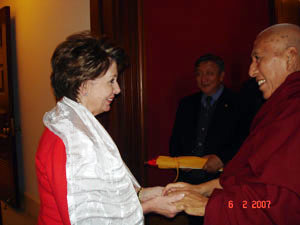
Prof. Samdhong Rinpoche, Chairman of the Tibetan Cabinet with Speaker of the House Nancy Pelosi.
The Speaker warmly welcomed the Kalon Tripa and Special Envoy Lodi Gyari and discussed plans for the next meeting she would be having with His Holiness the Dalai Lama.
Representative Tom Lantos, Chairman of the House Foreign Affairs Committee, also met with the Kalon Tripa and said that Tibet would be a priority in the Committee’s examination of US-China policy and, further, that it was his desire to schedule a hearing within the next weeks on the status of the dialogue between the Dalai Lama’s envoys and Chinese officials.
The Tibetan leader is on a week-long visit to Washington, D.C. to meet with Congressional and other US Government officials, and members of the Tibetan community, including US-based Tibetan officials. This is his first visit to the United States following his re-election as Kalon Tripa in June 2006.
Samdhong Rinpoche also visited the National Endowment for Democracy and met with its President, Carl Gershman. The NED provides grant assistance to democracy-promotion programs in Dharamsala, India, headquarters of the Central Tibetan Administration (CTA) of His Holiness the Dalai Lama.
Rinpoche heads the CTA’s executive branch (Kashag). Until 1990, members of the Kashag were appointed by the Dalai Lama. As part of an effort to further democratize the Tibetan polity, the Dalai Lama devolved the authority to elect the members of the Kashag to the Tibetan Parliament. In the late 1990s, the Dalai Lama called for further changes so that the Chairman of the Kashag is directly elected by the Tibetan people. After several years of discussion, the Assembly adopted such a proposal in 2001. Prof. Samdhong Rinpoche became the first to be elected to this position.
In testimony on Tibetan democracy before the Congressional Human Rights Caucus in in December 2001, Eva Herzer of the Tibet Justice Center, commented on this development saying: “Having that person (the Kalon Tripa) chosen by popular election represents a major shift in the Tibetan political landscape. Up to now, the only person who enjoyed clear and undisputed leadership status in the Tibetan society was His Holiness.”
Prof. Samdhong Lobsang Tenzin, the 5th Samdhong Rinpoche, was born on November 5, 1939 in Tibet. At age five, he was recognized as the reincarnation of 4th Samdhong Rinpoche and enthroned in Gaden Dechenling Monastery in his village of Jol (in present-day Dechen Tibetan Autonomous Prefecture, Yunnan Province). He was educated in Drepung Monastery in Lhasa. He fled to India in 1959 after the Chinese occupation of Tibet. He served as a teacher in Tibetan schools in Shimla and Darjeeling and as principal ofthe school in Dalhousie, all in India.
From 1971 to 2001 he served as the Principal and subsequently as the Director of the internationally-renowned Central Institute of Higher Tibetan Studies (CIHTS, Varanasi). In 1990, he was a member of the Committee that drafted the Charter for the Tibetans in exile. From 1991 to 1995 he was specially appointed to the Assembly of Tibetan People’s Deputies by His Holiness the Dalai Lama and was unanimously elected as Chairman. From 1996 to 2001 he served as an elected representative of Kham province and continued as Chairman.
In 2006, Rinpoche received over 90 percent of votes cast to become the first Chairman of the Tibetan Cabinet to be directly elected by the Tibetan people. He has advocated Gandhi-style passive resistance instead of confrontational protest in dealing with Beijing and has become a crucial player in the political changes taking place in the Tibetan exile world. Rinpoche is a steadfast supporter of His Holiness the Dalai Lama’s Middle Way approach, which seeks a negotiated solution for Tibet based on genuine autonomy within the People’s Republic of China.
“Political separation from China is not important,” Rinpoche has said. “What is important is to restore Tibetan civilization. Tibet is not simply a nation or state. It is a unique cultural and spiritual heritage. It could be preserved within China – or it could not be preserved even if we were separate from China. Our basic objective is to preserve it in future for the benefit of all humanity, all sentient beings.
“China is not our enemy,” Samdhong Rinpoche said. “China is a people who need our cooperation, who need our guidance, spiritually. It has been so for more than 1,000 years.”

